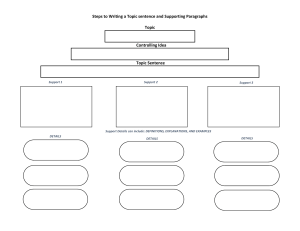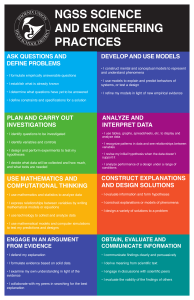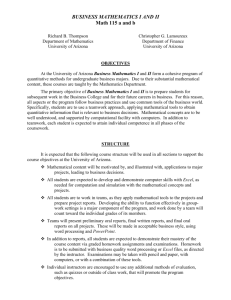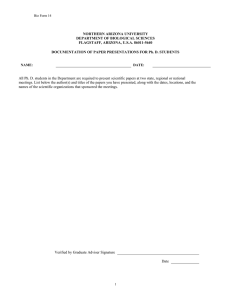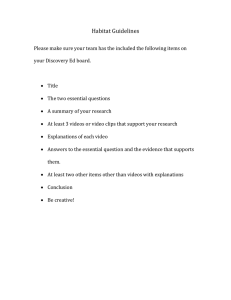Arizona Grade 1 Math Standards: Number & Operations
advertisement
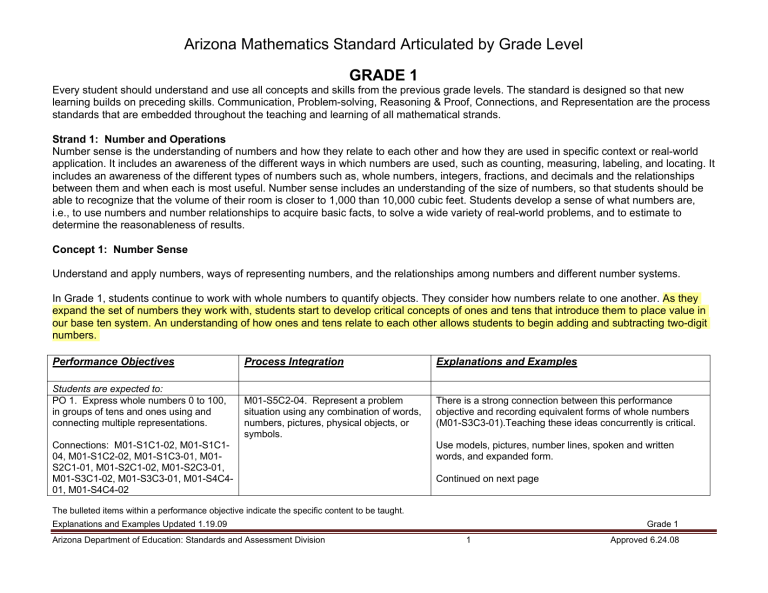
Arizona Mathematics Standard Articulated by Grade Level GRADE 1 Every student should understand and use all concepts and skills from the previous grade levels. The standard is designed so that new learning builds on preceding skills. Communication, Problem-solving, Reasoning & Proof, Connections, and Representation are the process standards that are embedded throughout the teaching and learning of all mathematical strands. Strand 1: Number and Operations Number sense is the understanding of numbers and how they relate to each other and how they are used in specific context or real-world application. It includes an awareness of the different ways in which numbers are used, such as counting, measuring, labeling, and locating. It includes an awareness of the different types of numbers such as, whole numbers, integers, fractions, and decimals and the relationships between them and when each is most useful. Number sense includes an understanding of the size of numbers, so that students should be able to recognize that the volume of their room is closer to 1,000 than 10,000 cubic feet. Students develop a sense of what numbers are, i.e., to use numbers and number relationships to acquire basic facts, to solve a wide variety of real-world problems, and to estimate to determine the reasonableness of results. Concept 1: Number Sense Understand and apply numbers, ways of representing numbers, and the relationships among numbers and different number systems. In Grade 1, students continue to work with whole numbers to quantify objects. They consider how numbers relate to one another. As they expand the set of numbers they work with, students start to develop critical concepts of ones and tens that introduce them to place value in our base ten system. An understanding of how ones and tens relate to each other allows students to begin adding and subtracting two-digit numbers. Performance Objectives Students are expected to: PO 1. Express whole numbers 0 to 100, in groups of tens and ones using and connecting multiple representations. Process Integration Explanations and Examples M01-S5C2-04. Represent a problem situation using any combination of words, numbers, pictures, physical objects, or symbols. There is a strong connection between this performance objective and recording equivalent forms of whole numbers (M01-S3C3-01).Teaching these ideas concurrently is critical. Connections: M01-S1C1-02, M01-S1C104, M01-S1C2-02, M01-S1C3-01, M01S2C1-01, M01-S2C1-02, M01-S2C3-01, M01-S3C1-02, M01-S3C3-01, M01-S4C401, M01-S4C4-02 Use models, pictures, number lines, spoken and written words, and expanded form. Continued on next page The bulleted items within a performance objective indicate the specific content to be taught. Explanations and Examples Updated 1.19.09 Arizona Department of Education: Standards and Assessment Division Grade 1 1 Approved 6.24.08 Arizona Mathematics Standard Articulated by Grade Level Performance Objectives Process Integration Explanations and Examples Students are expected to: Example: • Twenty-seven objects can be grouped as 2 tens and 7 ones, regrouped as 1 ten and 17 ones, and regrouped again as 27 ones. The total (27) remains constant. This type of grouping lays a foundation for future work with addition and subtraction of two-digit numbers, where renaming 27 as 10 + 17 may be necessary. 27 = 10 + 10 + 7 PO 2. Count forward to 100 and backward from 100 by 1s and 10s using different starting points, and count forward to 100 by 2s and 5s. M01-S5C2-04. Represent a problem situation using any combination of words, numbers, pictures, physical objects, or symbols. Connections: M01-S1C1-01, M01-S1C202, M01-S1C3-01, M01-S2C1-01, M01S2C1-02, M01-S3C1-02, M01-S4C4-01 PO 3. Identify numbers which are 10 more or less than a given number to 90. M01-S5C2-05. Explain and clarify mathematical thinking. Connections: M01-S1C2-02, M01-S3C102 27 = 10 + 17 27 Students should apply their number sense when graphing, patterning, sorting, and measuring. Objects, number lines, and hundred charts are examples of models which can be used to illustrate skip counting. Examples: • “Start at 93. Count backward. I’ll tell you when to stop.” [Stop when the student has counted backward ten numbers.] • “Start at 24. Count up by 10s. I’ll tell you when to stop.” [Stop when the student has counted to 94 by 10s.] Examples: • 10 more than 43 is 53 (one more 10) • 10 less than 43 is 33 (one less 10) The bulleted items within a performance objective indicate the specific content to be taught. Explanations and Examples Updated 1.19.09 Arizona Department of Education: Standards and Assessment Division Grade 1 2 Approved 6.24.08 Arizona Mathematics Standard Articulated by Grade Level Performance Objectives Process Integration Explanations and Examples Students are expected to: PO 4. Compare and order whole numbers through 100 by applying the concepts of place value. M01-S5C2-05. Explain and clarify mathematical thinking. There is a strong connection between this performance objective and representing numbers (M01-S3C3-02). Teaching these ideas concurrently is critical. Connections: M01-S1C1-01, M01-S1C301, M01-S2C1-02, M01-S3C3-02 Comparative language includes but is not limited to more than, less than, greater than, most, greatest, least, same as, equal to. The symbols include = and ≠. To compare two-digit numbers, students first attend to the number of tens, then, if necessary, to the number of ones. Students use models, pictures, number lines, and spoken or written words to compare or order numbers. PO 5. Recognize and compare ordinal numbers, first through tenth. Connections: M01-S4C4-03 M01-S5C2-04. Represent a problem situation using any combination of words, numbers, pictures, physical objects, or symbols. The bulleted items within a performance objective indicate the specific content to be taught. Explanations and Examples Updated 1.19.09 Arizona Department of Education: Standards and Assessment Division Grade 1 3 Approved 6.24.08 Arizona Mathematics Standard Articulated by Grade Level Strand 1: Number and Operations Concept 2: Numerical Operations Understand and apply numerical operations and their relationship to one another. In Grade 1, students learn how to add and subtract using multiple strategies. They learn when to add and subtract and how addition and subtraction relate to each other. Understanding the relationship between addition and subtraction is an important part of learning these operations efficiently and accurately. Performance Objectives Process Integration Explanations and Examples Students are expected to: PO 1. Solve contextual problems using multiple representations for addition and subtraction facts. M01-S5C2-01. Identify the question(s) asked and any other questions that need to be answered in order to find a solution. There is a strong connection between this performance objective and representing word problems requiring addition or subtraction facts in an equation (M01-S3C3-03). Teaching these ideas concurrently is critical. Connections: M01-S1C2-02, M01-S1C203, M01-S1C2-04, M01-S1C2-05, M01S2C1-02, M01-S3C1-02, M01-S3C3-03 M01-S5C2-02. Identify the given information that can be used to find a solution. M01-S5C2-03. Select from a variety of problem-solving strategies and use one or more strategies to arrive at a solution. M01-S5C2-05. Explain and clarify mathematical thinking. M01-S5C2-06. Determine whether a solution is reasonable. Contextual problems that are closely connected to students’ lives should be used often to develop fluency with addition facts through 10 + 10 and the related subtraction facts. Examples: Note that in contextual problems subtraction as “take-away” is less complex for students than subtraction as “comparison.” • Take-away example: Abel has 9 balls. He gave 3 to Susan. How many balls does Abel have now? • Comparison example: Abel has 9 balls. Susan has 3 balls. How many more balls does Abel have than Susan? The bulleted items within a performance objective indicate the specific content to be taught. Explanations and Examples Updated 1.19.09 Arizona Department of Education: Standards and Assessment Division Grade 1 4 Approved 6.24.08 Arizona Mathematics Standard Articulated by Grade Level Performance Objectives Process Integration Explanations and Examples Students are expected to: PO 2. Demonstrate addition and subtraction of numbers that total less than 100 by using various representations that connect to place value concepts. M01-S5C2-04. Represent a problem situation using any combination of words, numbers, pictures, physical objects, or symbols. To develop grouping concepts, students need many opportunities to add groups of 10s to any 2 digit number, add numbers that make groups of 10, and subtract groups of 10 from a 2 digit number. Examples: • 23 + 40, count up by 10s, to get 33, 43, 53, 63 • 24 + 6, 4 + 6 =10 so now there are 3 tens or 30 • 57 – 30, 5 tens take-away 3 tens leaves 2 tens so the answer is 2 tens and 7 or 27 Connections: M01-S1C1-01, M01-S1C102, M01-S1C1-03, M01-S1C2-01, M01S1C2-05, M01-S2C1-02, M01-S3C3-01, M01-S3C3-02, M01-S3C3-03 Students use objects, pictures and explore several strategies to solve problems such as 32 + 45 and 23 + 38. PO 3. Develop and use multiple strategies for addition facts to 10+10 and their related subtraction facts. M01-S5C2-03. Select from a variety of problem-solving strategies and use one or more strategies to arrive at a solution. Connections: M01-S1C2-01, M01-S1C204, M01-S1C2-05, M01-S2C1-02, M01S3C1-02, M01-S3C3-01, M01-S3C3-02, M01-S3C3-03 Note: The intent of this performance objective is not to introduce traditional algorithms or rules. Students use the following strategies to understand addition and subtraction facts: • Acting out the problem • Using objects • Drawing pictures • Using 5 and 10 frames • Using number lines • Using 100 charts Continued on next page The bulleted items within a performance objective indicate the specific content to be taught. Explanations and Examples Updated 1.19.09 Arizona Department of Education: Standards and Assessment Division Grade 1 5 Approved 6.24.08 Arizona Mathematics Standard Articulated by Grade Level Performance Objectives Process Integration Explanations and Examples Students are expected to: PO 4. Create word problems based on addition and subtraction facts. Connections: M01-S1C2-01, M01-S1C203, M01-S1C3-01, M01-S2C1-02, M01S3C3-03 PO 5. Apply properties to solve addition/subtraction problems • identity property of addition/subtraction and • commutative property of addition. M01-S5C2-01. Identify the question(s) asked and any other questions that need to be answered in order to find a solution. The following Grade 1 strategies will prepare students to develop quick recall of addition and subtraction facts in Grade 2: • 0, 1 or 2 more/less than • Counting on • Counting back • Making tens • Adding nine using “plus 10, minus 1” • Using doubles • Using near doubles (Ex: 5 + 6 is 5 + 5 plus 1 more) • Subtracting by counting up (Ex: 8 – 3. count up from 3, that is, 4, 5, 6, 7, 8) There is a strong connection between this performance objective and representing word problems requiring addition or subtraction facts in an equation (M01-S3C3-03).Teaching these ideas concurrently is critical. M01-S5C2-02. Identify the given information that can be used to find a solution. Students use addition facts up to 10 + 10 and the related subtraction facts to create their word problems. M01-S5C2-05. Explain and clarify mathematical thinking. Example: • For the equation 7 + ? = 10, a possible story is: Jeff had 7 marbles in his pocket and some marbles in his drawer. He had 10 marbles altogether. How many marbles did he have in his drawer? Show your answer in pictures or words or using objects. Students should understand the important ideas of these properties. Connections: M01-S1C2-01, M01-S1C202, M01-S1C2-03, M01-S3C3-01, M01S3C3-03 12 = 12 + 0 16 – 0 = 16 3+4=4+3 Understanding the meaning of the equal sign as “the same quantity as” is foundational to these concepts The bulleted items within a performance objective indicate the specific content to be taught. Explanations and Examples Updated 1.19.09 Arizona Department of Education: Standards and Assessment Division Grade 1 6 Approved 6.24.08 Arizona Mathematics Standard Articulated by Grade Level Strand 1: Number and Operations Concept 3: Estimation Use estimation strategies reasonably and fluently while integrating content from each of the other strands. In Grade 1, students use five, ten, and twenty as benchmark numbers to develop their sense of quantity as well as to compare numbers. Performance Objectives Process Integration Explanations and Examples Students are expected to: PO 1. Use estimation to determine if sums are more or less than 5, more or less than 10, or more or less than 20. M01-S5C2-03. Select from a variety of problem-solving strategies and use one or more strategies to arrive at a solution. Connections: M01-S1C1-01, M01-S1C102, M01-S1C1-04, M01-S1C2-04 M01-S5C2-06. Determine whether a solution is reasonable. Estimating quantities helps students further develop their sense of number as well as their ability to compare and order numbers. Experiences of estimating sums without computing are important because it requires students to examine the relationships between the numbers. Examples: • 6 + 6 is more than 10 because 5 + 5 is 10 • 13 + 16 is more than 20 because there are more than 2 tens (extension: there are almost 3 tens) The bulleted items within a performance objective indicate the specific content to be taught. Explanations and Examples Updated 1.19.09 Arizona Department of Education: Standards and Assessment Division Grade 1 7 Approved 6.24.08 Arizona Mathematics Standard Articulated by Grade Level Strand 2: Data Analysis, Probability, and Discrete Mathematics This strand requires students to use data collection, data analysis, statistics, probability, systematic listing and counting, and the study of graphs. This prepares students for the study of discrete functions as well as to make valid inferences, decisions, and arguments. Discrete mathematics is a branch of mathematics that is widely used in business and industry. Combinatorics is the mathematics of systematic counting. Vertex-edge graphs are used to model and solve problems involving paths, networks, and relationships among a finite number of objects. Concept 1: Data Analysis (Statistics) Understand and apply data collection, organization, and representation to analyze and sort data. In Grade 1, students are introduced to basic ideas of data analysis by collecting and visually representing data. These ideas reinforce their understanding of whole numbers and addition and subtraction as students ask and answer questions about the data. As they move through the grades, students continue to apply what they learn about data, making mathematics relevant and connecting numbers to applied situations. Performance Objectives Students are expected to: PO 1. Collect, record, organize, and display data using tally charts or pictographs. Connections: M01-S1C1-01, M01-S1C102, M01-S2C1-02, SC01-S1C2-04, SC01S1C4-01 PO 2. Ask and answer questions by interpreting simple displays of data, including tally charts or pictographs. Connections: M01-S1C1-01, M01-S1C102, M01-S1C1-04, M01-S1C2-01, M01S1C2-02, M01-S1C2-03, M01-S1C2-04, M01-S2C1-01, SC01-S1C4-01 Process Integration Explanations and Examples M01-S5C2-04. Represent a problem situation using any combination of words, numbers, pictures, physical objects, or symbols. Students work with pictographs that have pictures representing a quantity of one. M01-S5C2-01. Identify the question(s) asked and any other questions that need to be answered in order to find a solution. The graphical representations include those listed in M01S2C1-01 and all other applicable representations taught in previous grade levels. The data chosen or questions asked give students opportunities to reinforce many performance objectives such as addition and subtraction facts, counting by fives and tens, identifying ten more and ten less, and using comparative language. M01-S5C2-02. Identify the given information that can be used to find a solution. Students answer questions as well as compose their own questions based on the data, charts, or graphs. The bulleted items within a performance objective indicate the specific content to be taught. Explanations and Examples Updated 1.19.09 Arizona Department of Education: Standards and Assessment Division Grade 1 8 Approved 6.24.08 Arizona Mathematics Standard Articulated by Grade Level Strand 2: Data Analysis, Probability, and Discrete Mathematics Concept 2: Probability Understand and apply the basic concepts of probability. In Grade 1, there are no performance objectives in this concept. Performance objectives begin in Grade 4. Strand 2: Data Analysis, Probability, and Discrete Mathematics Concept 3: Systematic Listing and Counting Understand and demonstrate the systematic listing and counting of possible outcomes. In Grade 1, students sort objects using a Venn diagram and describe how they sorted them. Performance Objectives Process Integration Explanations and Examples Students are expected to: PO 1. Use Venn diagrams to sort, classify, and count objects and justify the sorting rule. M01-S5C2-05. Explain and clarify mathematical thinking. Initially, first graders are introduced to Venn diagrams through sorting objects into disjoint sets (i.e., non-intersecting Venn diagrams). After completing their sort, they explain their sorting rule, draw a circle around each group, and label each group with a word that describes what the objects have in common. They also talk about what attributes are “different” and if any objects possess both attributes (in the disjoint case, no objects will have possess both attributes). Connections: M01-S1C1-01, M01-S4C102, SC01-S1C3-01, SC01-S5C1-01, SC01-S5C1-02 Children should also be given a Venn diagram of two nonintersecting groups that are labeled (for example, BIG and YELLOW) where they need to draw examples of objects that can go inside the circles and outside the circles. Perhaps they might draw a house inside the circle labeled BIG, a banana inside the circle labeled YELLOW, and a cucumber outside of the circles because it is both NOT BIG and NOT YELLOW. Continued on next page The bulleted items within a performance objective indicate the specific content to be taught. Explanations and Examples Updated 1.19.09 Arizona Department of Education: Standards and Assessment Division Grade 1 9 Approved 6.24.08 Arizona Mathematics Standard Articulated by Grade Level Performance Objectives Process Integration Explanations and Examples Students are expected to: By the end of the school year, students are introduced to the idea that some objects may share both attributes and explore sorting situations in Venn diagrams with one intersecting region. Extending the BIG and YELLOW example, students might draw a school bus inside the region to represent an object that is both BIG and YELLOW. They should use words to describe the objects found in all four regions: 1) BIG, 2) YELLOW, 3) BIG and YELLOW, and 4) NOT BIG and NOT YELLOW. Big Yellow Banana Dinosaur Building Bus Pencil Lemon Ladybug Dime Strand 2: Data Analysis, Probability, and Discrete Mathematics Concept 4: Vertex-Edge Graphs Understand and apply vertex-edge graphs. In Grade 1, there are no performance objectives in this concept. Performance objectives begin in Grade 2. The bulleted items within a performance objective indicate the specific content to be taught. Explanations and Examples Updated 1.19.09 Arizona Department of Education: Standards and Assessment Division Grade 1 10 Approved 6.24.08 Arizona Mathematics Standard Articulated by Grade Level Strand 3: Patterns, Algebra, and Functions Patterns occur everywhere in nature. Algebraic methods are used to explore, model and describe patterns, relationships, and functions involving numbers, shapes, iteration, recursion, and graphs within a variety of real-world problem solving situations. Iteration and recursion are used to model sequential, step-by-step change. Algebra emphasizes relationships among quantities, including functions, ways of representing mathematical relationships, and the analysis of change. Concept 1: Patterns Identify patterns and apply pattern recognition to reason mathematically while integrating content from each of the other strands. In Grade 1, students will continue to develop their understanding of repeating and growing patterns. Repeating patterns will be more sophisticated than in kindergarten. Students will notice that growing patterns involve addition and subtraction, and they will work with other types of patterns as they learn to make generalizations about what they observe. Performance Objectives Students are expected to: PO 1. Recognize, describe, extend, create, and record repeating patterns. Connections: M01-S4C1-01 PO 2. Recognize, describe, extend, create, and record growing patterns. Connections: M01-S1C1-01, M01-S1C102, M01-S1C1-03, M01-S1C2-01, M01S1C2-03 Process Integration Explanations and Examples M01-S5C2-04. Represent a problem situation using any combination of words, numbers, pictures, physical objects, or symbols. Repeating patterns repeat the same series over and over again. Oral or physical patterns as well as patterns produced with objects or symbols can be used. M01-S5C2-03. Select from a variety of problem-solving strategies and use one or more strategies to arrive at a solution. M01-S5C2-04. Represent a problem situation using any combination of words, numbers, pictures, physical objects, or symbols. Example: • The following pattern repeats ABCB over and over again: ABCB, ABCB, ABCB, ABCB, ABCB, … Growing patterns repeat the same process over and over again. Students use objects, pictures or numbers. Students look for growing patterns in a hundreds chart. Growing patterns can be used to reinforce addition and subtraction facts. Example: • Adding 5 over and over again results in a number pattern of 5, 10, 15, 20, 25, 30, 35, 40, … Adding 5 over and over can also be seen when counting the points on multiple stars or fingers on multiple hands. Continued on next page The bulleted items within a performance objective indicate the specific content to be taught. Explanations and Examples Updated 1.19.09 Arizona Department of Education: Standards and Assessment Division Grade 1 11 Approved 6.24.08 Arizona Mathematics Standard Articulated by Grade Level Performance Objectives Process Integration Explanations and Examples Students are expected to: Students recognize when patterns are the same even though the terms in the sequences may be different. Example: • Red, blue; red, blue, blue; red, blue, blue, blue; … and AB, ABB, ABBB, … have the same pattern even though the terms are different. Strand 3: Patterns, Algebra, and Functions Concept 2: Functions and Relationships Describe and model functions and their relationships. In Grade 1, there are no performance objectives in this concept. Performance objectives begin in Grade 2. The bulleted items within a performance objective indicate the specific content to be taught. Explanations and Examples Updated 1.19.09 Arizona Department of Education: Standards and Assessment Division Grade 1 12 Approved 6.24.08 Arizona Mathematics Standard Articulated by Grade Level Strand 3: Patterns, Algebra, and Functions Concept 3: Algebraic Representations Represent and analyze mathematical situations and structures using algebraic representations. In Grade 1, students work with and create number sentences in contextual situations as they construct equivalent forms of whole numbers and explore equations in their many forms. Performance Objectives Students are expected to: PO 1. Record equivalent forms of whole numbers to 100 by constructing models and using numbers. Process Integration Explanations and Examples M01-S5C2-04. Represent a problem situation using any combination of words, numbers, pictures, physical objects, or symbols. There is a strong connection to representing numbers (M01S1C1-01). Teaching these ideas concurrently is critical. Connections: M01-S1C1-01, M01-S1C202, M01-S1C2-03, M01-S1C2-05, M01S3C3-02 PO 2. Compare expressions using spoken words and the symbols = and ≠. M01-S5C2-05. Explain and clarify mathematical thinking. Connections: M01-S1C1-04, M01-S1C202, M01-S1C2-03, M01-S3C3-01 Example: • Students can be asked to make 45 in as many ways as possible. Some possibilities are: o 4 tens and a 5, recording the expression, 10 + 10 + 10 + 10 + 5 o 2 groups of 20 and a 5, recording the expression, 20 + 20 + 5 o Counting by 5s There is a strong connection to comparing and ordering numbers (M01-S1C1-04). Teaching these ideas concurrently is critical. Interchanging the language of “equal to” and “the same as” as well as “not equal to” and “not the same as” will help students grasp the meaning of these symbols. Students need to understand that equality means the same quantity as. This idea is critical if students are to avoid common pitfalls in later work with numbers and operations, where they may otherwise fall into habits of thinking that the answer follows the equal sign. Examples: • 7 = 8 – 1; 5 + 3 is the same amount as 10 – 2. • Two expressions, 3 + 4 and 5 – 2 can be compared resulting in “3 + 4 is not equal to 5 – 2”. The bulleted items within a performance objective indicate the specific content to be taught. Explanations and Examples Updated 1.19.09 Arizona Department of Education: Standards and Assessment Division Grade 1 13 Approved 6.24.08 Arizona Mathematics Standard Articulated by Grade Level Performance Objectives Students are expected to: PO 3. Represent a word problem requiring addition or subtraction facts using an equation. Process Integration Explanations and Examples M01-S5C2-04. Represent a problem situation using any combination of words, numbers, pictures, physical objects, or symbols. There is a strong connection to solving and creating contextual problems (M01-S1C2-01 and M01-S1C2-05). Teaching these ideas concurrently is critical. Connections: M01-S1C2-01, M01-S1C202, M01-S1C2-03, M01-S1C2-04, M01S1C2-05 Equation forms include: • a+b= • c–a= • c=a+ • c– =b Example: • Write a word problem that matches the equation: 8 + = 10 (a + = c). Sample answer: Tom has 8 cars. His brother gave him some more. He now has 10 cars. How many cars did his brother give him? Strand 3: Patterns, Algebra, and Functions Concept 4: Analysis of Change Analyze how changing the values of one quantity corresponds to change in the values of another quantity. In Grade 1, there are no performance objectives in this concept. Performance objectives begin in Grade 4. The bulleted items within a performance objective indicate the specific content to be taught. Explanations and Examples Updated 1.19.09 Arizona Department of Education: Standards and Assessment Division Grade 1 14 Approved 6.24.08 Arizona Mathematics Standard Articulated by Grade Level Strand 4: Geometry and Measurement Geometry is a natural place for the development of students' reasoning, higher thinking, and justification skills culminating in work with proofs. Geometric modeling and spatial reasoning offer ways to interpret and describe physical environments and can be important tools in problem solving. Students use geometric methods, properties and relationships, transformations, and coordinate geometry as a means to recognize, draw, describe, connect, analyze, and measure shapes and representations in the physical world. Measurement is the assignment of a numerical value to an attribute of an object, such as the length of a pencil. At more sophisticated levels, measurement involves assigning a number to a characteristic of a situation, as is done by the consumer price index. A major emphasis in this strand is becoming familiar with the units and processes that are used in measuring attributes. Concept 1: Geometric Properties Analyze the attributes and properties of 2- and 3- dimensional figures and develop mathematical arguments about their relationships. In Grade 1, students expand their knowledge of two-dimensional geometric figures by sorting, comparing, and contrasting them according to their characteristics. They learn important mathematical vocabulary used to name the figures. Students work with composite shapes made out of basic two-dimensional figures as they continue to develop their spatial sense of shapes, objects, and the world around them. Performance Objectives Process Integration Explanations and Examples Students are expected to: PO 1. Identify and draw 2-dimensional geometric figures based on given attributes regardless of size or orientation. M01-S5C2-02. Identify the given information that can be used to find a solution. Students identify, describe, and draw figures based on given attributes such as number of sides, number of vertices, etc. Figures include circles, triangles, and rectangles (including squares). Figures should also include other quadrilaterals, but students do not necessarily need to name them. Connections: M01-S3C1-01 By definition, a square is a special kind of rectangle. Although most first graders do not yet understand the hierarchy of shapes, it is good to teach with this idea in mind. In addition, a square turned on a vertex is still a square (not a diamond). Triangles should appear in many positions and orientations and should not all be equilateral or isosceles. The bulleted items within a performance objective indicate the specific content to be taught. Explanations and Examples Updated 1.19.09 Arizona Department of Education: Standards and Assessment Division Grade 1 15 Approved 6.24.08 Arizona Mathematics Standard Articulated by Grade Level Performance Objectives Students are expected to: PO 2. Compare and sort basic 2dimensional figures (including irregular figures) using attributes and explain the reasoning for the sorting. Process Integration Explanations and Examples M01-S5C2-05. Explain and clarify mathematical thinking. Students may sort a collection of two-dimensional figures into those that have straight sides and those that do not. This type of sorting differs from the color, size, and texture sorting commonly done in kindergarten. M01-S5C2-05. Explain and clarify mathematical thinking. Students use pattern blocks or plastic shapes to make new shapes. The teacher can give students cutouts of shapes and ask students to combine them to make a particular shape. Connections: M01-S2C3-01 PO 3. Describe the results of composing and decomposing 2-dimensional figures. Example: • What shapes can be made from four squares? • Students may also be asked to trace objects or use a drawing program to show different ways that a figure can be divided into different shapes. The bulleted items within a performance objective indicate the specific content to be taught. Explanations and Examples Updated 1.19.09 Arizona Department of Education: Standards and Assessment Division Grade 1 16 Approved 6.24.08 Arizona Mathematics Standard Articulated by Grade Level Strand 4: Geometry and Measurement Concept 2: Transformation of Shapes Apply spatial reasoning to create transformations and use symmetry to analyze mathematical situations. In Grade 1, there are no performance objectives in this concept. Performance objectives begin in Grade 2. Strand 4: Geometry and Measurement Concept 3: Coordinate Geometry Specify and describe spatial relationships using rectangular and other coordinate systems while integrating content from each of the other strands. In Grade 1, there are no performance objectives in this concept. Performance objectives begin in Grade 4. The bulleted items within a performance objective indicate the specific content to be taught. Explanations and Examples Updated 1.19.09 Arizona Department of Education: Standards and Assessment Division Grade 1 17 Approved 6.24.08 Arizona Mathematics Standard Articulated by Grade Level Strand 4: Geometry and Measurement Concept 4: Measurement Understand and apply appropriate units of measure, measurement techniques, and formulas to determine measurements. In Grade 1, students begin to understand what it means to measure, and they develop their measuring skills using everyday objects. As they practice using measurement tools to measure objects, they reinforce their sense of number and continue to develop their sense of space and shapes. Performance Objectives Process Integration Explanations and Examples Students are expected to: PO 1. Compare and order objects according to length, capacity, and weight. M01-S5C2-05. Explain and clarify mathematical thinking. Students can make direct comparison or measure using nonstandard units (using multiple units or using one unit multiple times). Suitable non-standard measuring units for young children include marbles or cubes for weight; paper clips, craft sticks, toothpicks, coffee stirrers, etc. for length; and filled paper cups to measure capacity. Connections: M01-S1C1-01, M01-S1C102, SC01-S1C1-01, SC01-S1C3-01, SC01-S5C1-01 Students describe the relationship between the size of the measurement unit and the number of units needed to measure something. For example, it takes more toothpicks than craft sticks to measure the width of my desk. The longer the unit the fewer I need. The idea of transitivity should also be included. For example, if Jon is taller than Jacob, and Jacob is taller than Luisa, then Jon is taller than Luisa. The bulleted items within a performance objective indicate the specific content to be taught. Explanations and Examples Updated 1.19.09 Arizona Department of Education: Standards and Assessment Division Grade 1 18 Approved 6.24.08 Arizona Mathematics Standard Articulated by Grade Level Performance Objectives Process Integration Explanations and Examples Students are expected to: PO 2. Measure and compare the length of objects using the benchmark of one inch. M01-S5C2-06. Determine whether a solution is reasonable. Students use “one-inch rulers”, such as one-inch paper strips or one-inch cubes, to measure the length of objects. Then they use rulers marked in one-inch increments. Connections: M01-S1C1-01, SC01S1C2-03 PO 3. Sequence the days of the week and the months of the year. Connections: M01-S1C1-05 Strand 5: Structure and Logic This strand emphasizes the core processes of problem solving. Students draw from the content of the other four strands to devise algorithms and analyze algorithmic thinking. Strand One and Strand Three provide the conceptual and computational basis for these algorithms. Logical reasoning and proof draws its substance from the study of geometry, patterns, and analysis to connect remaining strands. Students use algorithms, algorithmic thinking, and logical reasoning (both inductive and deductive) as they make conjectures and test the validity of arguments and proofs. Concept two develops the core processes as students evaluate situations, select problem solving strategies, draw logical conclusions, develop and describe solutions, and recognize their applications. Concept 1: Algorithms and Algorithmic Thinking Use reasoning to solve mathematical problems. In Grade 1, there are no performance objectives in this concept. Performance objectives begin in Grade 4. The bulleted items within a performance objective indicate the specific content to be taught. Explanations and Examples Updated 1.19.09 Arizona Department of Education: Standards and Assessment Division Grade 1 19 Approved 6.24.08 Arizona Mathematics Standard Articulated by Grade Level Strand 5: Structure and Logic Concept 2: Logic, Reasoning, Problem Solving, and Proof Evaluate situations, select problem-solving strategies, draw logical conclusions, develop and describe solutions, and recognize their applications. In Grade 1, students further develop the concept that doing mathematics involves solving problems and discussing what they did to solve them. Students continue to develop their mathematical communication skills as they participate in mathematical discussions involving questions like “How did you get that?”; “Why did you do that?”; and “How do you know that?” Students begin to build their mathematical vocabulary as they use correct mathematical language appropriate to grade 1. Performance Objectives Process Integration Students are expected to: Some of the Strand 5 Concept 2 performance objectives are listed throughout the grade level document in the Process Integration Column (2nd column). Since these performance objectives are connected to the other content strands, the process integration column is not used in this section next to those performance objectives. PO 1. Identify the question(s) asked and any other questions that need to be answered in order to find a solution. PO 2. Identify the given information that can be used to find a solution. PO 3. Select from a variety of problemsolving strategies and use one or more strategies to arrive at a solution. PO 4. Represent a problem situation using any combination of words, numbers, pictures, physical objects, or symbols. Explanations and Examples Problem solving strategies may include drawing pictures, using objects, acting out, making a chart or list, etc. Students need opportunities to connect the different representations and explain the connections. Representations should include numbers, words (including mathematical language), pictures, and/or physical objects. Students should be able to use all of these representations as needed. The bulleted items within a performance objective indicate the specific content to be taught. Explanations and Examples Updated 1.19.09 Arizona Department of Education: Standards and Assessment Division Grade 1 20 Approved 6.24.08 Arizona Mathematics Standard Articulated by Grade Level Performance Objectives Process Integration Students are expected to: Some of the Strand 5 Concept 2 performance objectives are listed throughout the grade level document in the Process Integration Column (2nd column). Since these performance objectives are connected to the other content strands, the process integration column is not used in this section next to those performance objectives. PO 5. Explain and clarify mathematical thinking. Explanations and Examples Students will often need to use objects and pictures to explain their thinking. Modeling different explanations to guide students is helpful. PO 6. Determine whether a solution is reasonable. The bulleted items within a performance objective indicate the specific content to be taught. Explanations and Examples Updated 1.19.09 Arizona Department of Education: Standards and Assessment Division Grade 1 21 Approved 6.24.08
